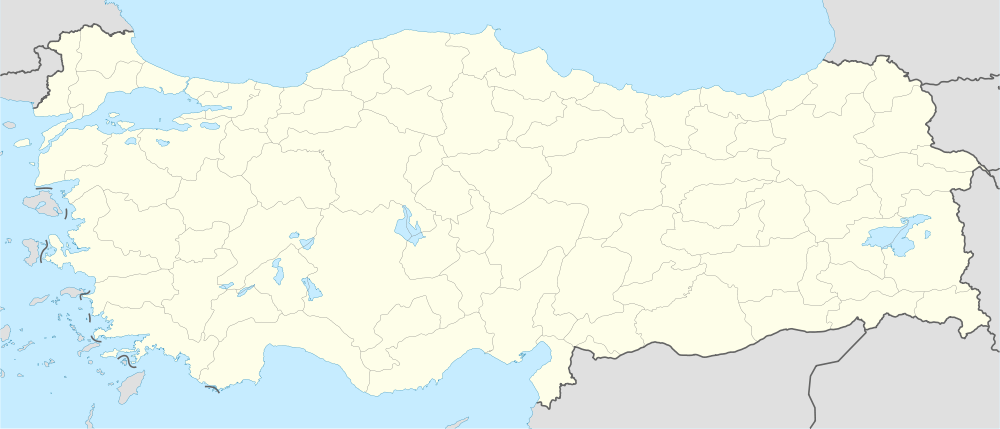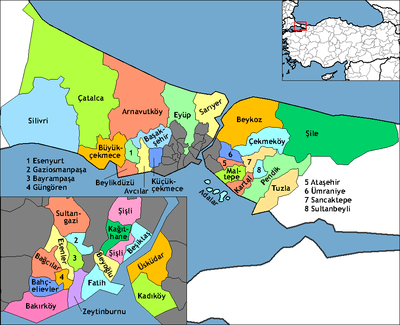Büyükçekmece
| Büyükçekmece | |
|---|---|
| district | |
|
The district of Büyükçekmece | |
 Location of Büyükçekmece in Istanbul | |
 Büyükçekmece Location of Büyükçekmece in Istanbul | |
| Coordinates: 41°01′12″N 28°34′39″E / 41.02000°N 28.57750°ECoordinates: 41°01′12″N 28°34′39″E / 41.02000°N 28.57750°E | |
| Country | Turkey |
| City | Istanbul |
| Government | |
| • Mayor | Hasan Akgün (CHP) |
| • Governor | Ismail Gündüz |
| Area[1] | |
| • District | 239.25 km2 (92.37 sq mi) |
| Population (2012)[2] | |
| • District | 201,077 |
| • District density | 840/km2 (2,200/sq mi) |
| Time zone | EET (UTC+2) |
| • Summer (DST) | EEST (UTC+3) |
| Area code(s) | 0-212 |
| Website |
www |
Büyükçekmece is a district and municipality (belediye) in the suburbs of Istanbul, Turkey on the Sea of Marmara coast of the European side, west of the city. It is largely an industrial area with a population of 380,000. The mayor is Hasan Akgün (CHP).
History
The land around this inlet of the Sea of Marmara, has been settled, abandoned and resettled throughout history as army after army passed along the coast to Istanbul. It is thought to be the site of the Greek colony on the Marmara shore called Athyra (Άθυρα), also known as Athyras.
In 443 AD, the armies of Attila the Hun took this settlement and its associated fort, and this was presumably his last conquest of that campaign before turning around.
The earliest mention of the bishopric of Athyra in a list of dioceses is of the late 15th century, but a seal has been found of a 10th-century Bishop Orestes of the see. No longer a residential bishopric, Athyra is today listed by the Catholic Church as a titular see.[3]
The Ottoman architect Mimar Sinan built a bridge to cross the mouth of the inlet (Lake Büyükçekmece) and there are ruins of inns and caravansarai, which show this was a stopping place on the road to Europe. At the beginning of the Ottoman period, it was empty forest and farmland, and has gradually been settled by Turkish people migrating in from the Balkans and the Caucasus.
In the early years of the Turkish Republic, it was still very rural, with village cottages, farmland behind, and by the sea the odd weekend home for people of Istanbul. The area was a very popular day or weekend trip from the city, there is a sandy shoreline, a long seafront and until the 1970s families would come out to Büyükçekmece for fishing, crabbing or for a day on the beach.
Büyükçekmece today
The area administered by Büyükçekmece includes a large hinterland behind the Marmara shore, some of it still rural.
In the centre of Büyükçekmece itself, there are still tea gardens on the seafront and other places for kids to play while their families sit, picnic and enjoy the sea views. These are now used by day trippers from the city, especially the nearby dense working-class housing areas such as Avcılar.
There are no holiday-makers now, they have moved further out from the city as since the 1950s the area has become industrialised, over-built with apartment buildings, and populated by migrants from Anatolia. Today, the inlet and the Marmara Sea are both very polluted and the infrastructure of an industrial city is now in place.
Lake Büyükçekmece was connected to the sea until it was separated by a dam to supply fresh water to Istanbul. The Mimar Sinan Bridge is located in this area.[4]
Twinned towns
-
 Gelsenkirchen, Germany (since 2004)
Gelsenkirchen, Germany (since 2004) -
 Struga, Macedonia (since 2015)
Struga, Macedonia (since 2015)
See also
References
- ↑ "Area of regions (including lakes), km²". Regional Statistics Database. Turkish Statistical Institute. 2002. Retrieved 2013-03-05.
- ↑ "Population of province/district centers and towns/villages by districts - 2012". Address Based Population Registration System (ABPRS) Database. Turkish Statistical Institute. Retrieved 2013-02-27.
- ↑ Annuario Pontificio 2013 (Libreria Editrice Vaticana 2013 ISBN 978-88-209-9070-1), p. 841
- ↑ Mülayim, Selçuk; Akşit, İlhan (2005). Turkish art and architecture in Anatolia & Mimar Sinan. Akşit. p. 135. ISBN 978-975-7039-22-8.
External links
- Official site of Büyükçekmece Municipality
- Satellite view of Büyükçekmece
- Buyukcekmece Culture And Art Fest

